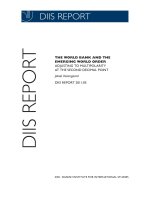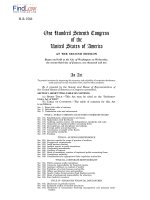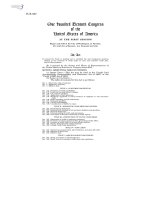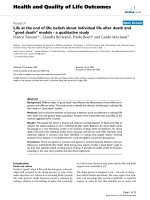Class 13 and class 14 reference 2 what should world leaders focus on at the johannesburg summit by simon upton
Bạn đang xem bản rút gọn của tài liệu. Xem và tải ngay bản đầy đủ của tài liệu tại đây (3.27 MB, 10 trang )
Appendix 2
((o
I
Organisation de Coopdrdtion ct dc Ddvcloppemqt Economiqucs
Organisation for Economic Co-operation and Developmcnt
English - Or. English
What Should World Leaders Focus on at the Johannesburg Summit?
RL Hon Simon Uptor
Chair
OECD Round Table on Sust ireble Development
This speech was delivered by Rl Hon Simon Upton in NEw Delhi, India on I I February 2002 at the DSDS 2002 Ensuring Sustainable Livelihoods: challenges for gove ments, corpordtes, and civil society at Rio+10. The
papet wat written with the qssistance of Yangelis Yitalis, Chief Adviser OECD Round Table on Sustainable
Developmenl
The views upressed do not necessarily represenl those ofthe OECD or any of its Member countries.
For furfier information please contact Vangelis Vitalis, Chief Adviser, OECD Round Table on
Sustainable Developmen! OECD, 2 rue Andre Pascal, 75015 Paris, tel: +33 1 45 2414 57;
fax +33 I 452479 31; email:
What should world leaders focus ou at the Johannesburg Summit?r
The paper addresses a single specific question: if world leaden decide to focus on the issues tlnt could
make the biggest difference, what would they be (assuming they decide to aftend the Johannesburg Wortd
Summit)?
T\e
1992 fuo Conference was about environment azd development. The implicit
and uneasy understanding was that tle ability of developing countries to engage on many environmental challenges
was dependent on their own economic development and the help of rich countries in faciliating it
Without that development part of the bargain being addresse4 there was never much prospect of truly
global engagement on some ofthe environmental concerns tlat came to the fore at Rio.
-
-
The paper is based on two premises:
l.
There is nothing remotely 'sustainable' about grinding poverty. Being poor in human and
physical resources is no passport to environmental sustainability - quite the opposite. A
combination of all or some of
. illiteracy,
.poor life expectancy,
.chronic public health challeuges,
.weak or dysfunctional govemment
.an absence ofclearly defined property rights and
.over-use ofcommon assets like clean water
makes for a spiral
2.
ofdecliniag ecological services and deepening poverty.
Leaders who spend time going to conferences should focus on the big issues first.
If world leaders really want to make a difference to the development prospects of
the 2.8 billion people
who live on less than US$2 per day, what are tbe policies they should target for immediate and urgent
attention?r The following provides a feet for the relative magritude of some of the options.
Offi ciel Development Assistence
Official development assistance is the most familiar. Current transfers from rich countries to the rest of the
world total $53.7 billion - that's down from $60.8 billion in 1992 (and represents, in real terms, a fall of
7/o).2 Since the Pearson Commission in 1969, a target for ODA of 0.7/o of the GDP of donor eounties
has been in vogue. It has been formally endorsed as a target to be aimed for on numerous occasions, most
recently in the Millennium Development Goals and again in the Zedillo report on Financing for
Development.
Should leaders focus on this option? Meeting it would take the total quantum ofODA from $53 billion to
$ 160 billion.3 It would certainly make a good deal of basic humaaitarian assistance possible. But there is
l.
Written with the assistance
Development
of Vangelis Vitalis, Chief Adviser, OECD Round Table on
Sustainable
not the slightest indication that anl,thing like this is going to be made available
countries are looking at significant cuts
-
indeed some donor
Philanthropy
It would be anomalous indeed if world leaders decided to spend their time exhorting private citizens to step
into the breach given the yawning gap between their owu rhetoric and performance. But for the sake of
completeness it is wortr recording the cunent state ofphilanthropy as a source ofdevelopment assistance if only to calibrate whether this is a source potentially worth waiting for.
Taken together, the available dara fr6m fhs US and Europe, the figure is significan! but not critical when
set against the other sources. Last year, charitable foundations on both sides of the Atlaatic donated
some,Iwhere between US$3 - 4
billion
-
and that's a generous estimate.a
Furthermore, the immediate outlook is bleak for private phitanthropy. It is a sector that has been hard hit
by the collapse in high tech stock values making any near-term upside look remote.s
Foreign Direct Investment
Would iq altematively, be plausible to maintain that private investrnent flows from developed to
developing counties should be the principat engine fdr development? First the statistics.
Certainly, FDI has shown more promise in terms of its t'ajectory than ODA. In 1992, flows to developing
countiei totalled $36 billion. By 1999 tlat figure was approaching 160 billion.5 Unquestionably, iucl
investment brings with it a range of direct and indirect benefits - employment skills and the 'crowding in'
of additional investment.
What can the political leaders of rich counties do to stimulate additional foreign direct investment? There
are some available policy tools, t\e_bg!!1!!!g legal capacity, or helping to cree&-Egns.pjte1!-4!4bq!trels
friendly environments. Some might be tempted to tum to export credit guarantee agencies to expand !'ade
flows and credit lines - but it has to be asked whether these are not even more seliserving than some oftle
direct aid grants that have been designed to create business for donor count-ies.
Ironically, many companies that are potentially large foreign investors would point to both the qtality and
quantity of ODA as a pre-condition to many markets becoming attractive. Without minimum levels of
education and personal health and security, the attractiveness of many countries is slight.
It is also important to acknowledge that white overall FDI figures are large, a small number of developing
counEies have attracted the lion's share of investnent. China alone, for instaace, has swallowed up
US$321 billion or 45% ofall ofthe investment flowing to the Asian region since 1990.
-
The reality is that not all developing countries are equally attractive to investors
and it's not always a
question of the quality of govemance and institutions. Take the Kyrryz Republic which, despite all its text
book reforms, attracted in 2000 only 10% of the FDI that poured into the Cent"al Asian Repubtics.
Countries with serious comrption and governance problems, but huge natural resources, have proved much
more attractive than this little country of 4 million people with few natural resources but hard-won WTO
membership.
At the most optimistic estimate, roughly one third of the 2.8 billion people refened to earlier live in
counties that are, at least currently, attractive to foreign investors. FDI will be a powerful engine for
development but it is by no means a complete solution.
But aside from that, it is hard to see why leaders would afiend a conference to promote something over
which they have relatively limited conrol.
Teking trede liberelisation seriously
Unlike the destination of capital flows, governments have very considerable influence over the basis on
which goods are permitted to flow across their own borders. Perhaps world leaders should choose to give
real impetus to pulling down some ofthe bariers that keep developing country goods out of their markets,
and eliminating the subsidies that help keep them uncompetitive? The numbers certainly male this look a
promising area
Subsidies paid out by OECD countries amount to berween US$560 billion and US$725 billion per year.'
Thal's more than tea times the figure for ODA and about three times the value of FDI flows to developing
countries.
Take the main offender, agriculture. This sector absorbs some $362 billion a year in subsidies from OECD
counties,. or 1.4Yo of those countries GNP. Compare .this figure to the O.24Yo of GNP provided in
development assistance by those same countries.
The specific statistics are barely conscionable. Last year, the EU spent over US$2 billion on subsidising
EU sugar farmers alone to produce a product which can be produced more efficiently and cheaply in the
developing world. Similarly, in the US, individual oilseed farmers received nearly US$12,000 per year in
support.r Compare tlat to the average wages in most developing countries. Overall tariffs and subsidies in
the developed world cause annual welfare losses of almost US$20 billion for developing countries.e This
is equal to some 40% of annual ODA provided by OECD countries to the developing world.lo
Regional snapshots of the impact of these policies paint an even grimmer picture. Sub.Saharar AAican
countries, for instance, suffer an annual bade loss ofUS$20 billion because of the combined effect oftadff
quotas, barriers and subsidies. That figure is US$6 billion more than ODA disbursed in the region.
What would the value of trade liberatisation be worth to developing countries? Estimates vary. Based on
what we know of other liberalisation efforts, the outcomes can only be positive. Take NAFTA, which
increased trade and b-oosted employm ent by 22Yo ia Mexico, l0% in Canada and 7% in the United States.lr
More generally, the World Bank has estimated that removing obstacles to trade would boost the incomes of
developing counties by anlthing from US$200 billion to US$500 billion a year.'2 Even if one takes the
lower estimate, this is almost the same as current FDI and ODA flows combined. If world leaders were
going to talk seriously about t'ade liberalisation, therefore, they would be talking about some seriously big
numbers.
Opening borders to people
has become commonplace to describe the planet as a global village. The Intemet and television have
made it possible for one half of the world to see a glamorised version of how the other half lives. People
are understandably determined to try to gain access to this.enhanced quality ard quantity of life. To this
pt€ssures of war, persecution,
general pressure for migration mUst be added the specific - but related
violence and the denial of human righs.
It
-
Thal pressue is currently held at bay by skingent immigration contols in rich countries. One other way to
improve the development prospects of poorer countries would be to extend the argument for free trade in
goods and services, to the free movement of people.
It would
be a powerful
- and controversial
- way
The most direct benefrt migra.tion provides to developing countries is through expatriate remittances. The
total value ofglobal remitances has risen from less tlran US$2 billion in 1970 to aknost US$I00 billiogj!
1999.13 The importance of remittances varies but for a number of developing countries they are a critically
important source
of
income and foreign bxchange.
Egrp! for instance, received US$5.1 billion
in
not far short of the US$6.9 biltion income received from the Suez Canal, oil expotu and
remittances
tourism combined. According to the Central Bank ofthe Philippines, that county's economy has benefited
by upwards of US$7 billion in the form of remittances (easily dwarfi4g ODA and FDI flows over the same
period).la Jamaica has benefited from a stee! increase in remittances, with an increase over a ten-year
period from 4% of GDP to nearly l0%."
-
.
Some doubt the development benefit of migrant remittances on the grounds that they tend to fund
oonsumptiorL not inveshnent. But it is undeniable that many forms of consumption such as housing better
food education and health will improve productivity and thus development prospects. A more toublesome
issue may be a potential loss of skills to economies that have few enough in the first place. For all tha!
whafmight one expect from even a relatively minor easing of the migration rest-ictions currently in place
in developed countries?
five leading economies ofthe G7 could be persuaded to approve work permits
for an inflow of migrant workers equivalenl to 4Yo of their current work force. The returns to developing
-cout-y
economies alone can plausibly be estimated to be of the order of US$200 biilion (while the gains
Suppose, for instance, the
to global e.conomic welfare are much higher again).'o Contrast ttrat with the potential gains from the Trade
Round which, if delivered, might on past experience not acoally accrue until as much as fle years aJter
the Round is completed - whenever that is.
Conclusions
Putting these possible engines for development side by side, it is not hard to see where the largest possible
gains could be made. Table One (below) shows these numbers. They are rough - but defensible - estimates.
They show that the sort of development gains that a combined cross-border liberalisation of product and
labour markets would produce are roughly an order ofmapitude greater than the current level ofODA for
which there appears to be little prospect ofupside.
So does this mean dlat leaders will weigh their priorities accordingly? This remains unclear. Any fair
presenBtion of this table would have to observe that the political diffrculties of opening borders to more
migrants are probably an order of magnitude more difficult than voting a little more for ODA budgets.
The figures tell their orln story. One important point is worth emphasising: leaders should not try to cover
their inaction on any of these fronts with words. That has been the past practice. Developed countrieS
have been 'aiming' to lift their ODA to 0.7% GDP for a very long time. It hasn't happ€ned. The draft text
for the forthcoming Monterey Conference on Financing for Development limply 'acknowledges' concem
on a raft of issues such as non-tariff baniers and tariff escalation.
There is a fairly high level of summit fatigue out ther€. There have been too many declarations without
follow through and not just on development. One thinks of the FCCC with is 'aim to, target of
stabilising greenhouse gas emissions at 1990 levels. If leaders are not in a position to make commitrnents
they should be plain about that. It will be small comfort for those hoping for major gains, but a concrete
list of positive initiatives - however modest - would be preferable. Whether that would be enough to give
environment ministers hope of progress in their field is another matter. Besause it is as clear today - as it
-
was ar fuo - that no country is going to sign up to a serious environmental agenda by surrendering its right
to development.
Possible Sources
of Assistance to
Developing
-
Countries
"Ballpark Figures"
' OeCO 1ZOOI4,
r
o
The
DAC Journal: Developnent Co-operation 2000 Report, OECD, Pads
Alt calculations adjusted to current prices and exchange
rates, based on data Aom OECD (2001a).
US figurc drawn from The Chroniclc of Philanthropy (2002) Washitrgton (hsp://philanthopy.com/). European
figures for philanthropic foundation wort with developing counties are drawn from a range of sources,
including in particular the European Foundation (2001 and htp://www.efc.beA. No Japanese figures were
available.
by Duraad, J., Panado, E., ad Massey, D., (1996) Migradollars and Dzvelopment: A Reconsideration of the M*ican
Case, lnternational Migration Review 30, no. 2
15
Figures based on the assumption that the five leadilg economies of the G7 approved wort permits for al inflow of
migrdnt worters equivalent to 4% of tleir currcnt work force. Estimating the impact of such changes is always
difficult and wlnerable to the vagaries of econometric models. The figures used here have been pulled together Aom
data held by the Intemalional Migration Organisation (2000) and the Intemational Labour Organisation (see in
particular Stalker, P., Q000) Workers withoul Ftotttie6,ILO, Geneva). The distfuution ofprojected migration flows
was based on past flows to the economies concemed and a breakdown of the skille4 semi and unskilled worker
categories, with the proportions used for the 4% incrcase mirroring the growth,lorigin t'ajectories for immigration
extant in the preceding three years and weighted accordingly. Some of the figures have been re"ised dowawards in
light of concems expressed in the literature about the methodologies applied
"
Figure assumes that all DAC members meet the 0.7% of GNP stipulated by the Pearson Commission in 1969.
Figure is derived Aom the author's calculations based on data contained h OECD Q002) The DAC
Journal: Development Co-operation 2001 Report, OECD, Paris (forthcoming)
rE
US figure drawn from The Chronicle of Philanthropy (2002). Euopean figures for philanthropic foundation work
with developing countries are drawn from a range of sources, including in particular the European
Foundation (2001 and . No Japanesc figures were available.
re
The figures cited are drawn from Intemational Monetary Fund (2001) World Economic OntloolqBvff, Washington.
Given that economies in c'ansition do not quafiry for ODA funds under the DAC criteri4 FDI data to these economies
excluded
World Bank (2001) and other sources. These figures are all based on a ralge of assumptions and use a wealth
data, frequently based on the GTAP model.
has beeu
?0
of
Estimating thesc flows is difficult and there is as yet no universal agreement as to how it should be done. The
figures
used here are derived by adding three categories in the IntematioDal MoDetary Funds balance ofpayment statistics
(workers remittances, migrdnt tra$fers and compensation income). Unfortunately, this is an imprecise science. Tbe
interpretation ofthesc categories differs &om county to counry and banks do not report the data consistently. The
top group of countries in totalremittance terms in 1999 were Mexico, Eryp! Turkey and the Philippines, accounting
for around one-third ofthe total. One major weakness with these figures (and those cited subsequently) is that they
fail to capture the transfen, which take place through informal channels. lvlicrostudies indicate that, in many
counEies, less than half of the remittances flow through official channels.
2 Figures based on the assumption that the five leading economies ofthe G7 approved work permits for an inflow of
migrd workers equivalent to 4% of their current work force. Estimating the impact of such changes is always
difficult and wlnerable to the vagaries ofeconometic models. The figures used here have beeo drann from data held
by the tnternational Migra.tion Organisation (2000) and the htemational Labour Organisatior (see in particular
Stalker 2000) and brought together by the author's calculations. The distribution of projeaed migration flows was
based on past flows to the economies concemed and a breakdown ofthe skille4 semi and unskilled worker categories,
with the proportions used for the 4o/o incrcase mirroring thc gro*tVorigin Fajectories for immigration extant in the
preceding three years aad weighted accordingly. Some of the figures have been revised downwards (author's
calculations) in light ofconcems expressed in the literatue about the methodologies applied2r









